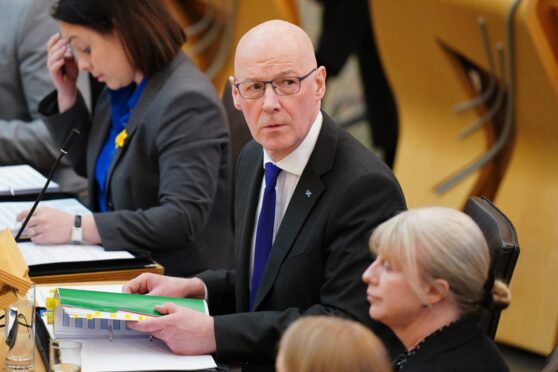The number of full-time staff at Tayside and Fife councils has been slashed by 4,500 since the financial crash, The Courier can reveal.
There has been a “staggering” 13% drop in the local government workforce across Courier Country since 2008.
It mirrors the sharpness of the national decline, with more than 28,000 council jobs lost across Scotland in the past seven years.
Unions say the slashing of the workforce shows that workers are being punished for a financial crisis they did not cause.
Local authorities, which have seen their core budgets heavily slashed over the decade, have warned more job losses are on the way as councils are forced to change the way they operate.
Pat Rafferty, Unite’s Scottish secretary, said: “These figures are
staggering.
“They show that local government workers have paid the price for the financial crisis which was not of their making.
“They have paid the price in wages. And clearly, as these figures show, they have also paid the price in jobs.”
Mr Rafferty added: “Local government has been hit by a double whammy – years of Tory austerity combined with those cuts and more being passed on here by the Scottish Government.
“Alas the finance secretary’s recent budget shows there is more pain to come. It’s time for an alternative to this permanent austerity which has achieved nothing.”
Monica Lennon, for Scottish Labour, said the numbers “show the human cost of SNP cuts”.
“Thousands of council jobs have been lost in Tayside and Fife since the
SNP came to power – cuts forced on
Scotland’s most vulnerable communities by a government that is supposed to protect them,” she said.
Last month’s Scottish draft Budget showed that councils in Tayside and Fife will see their 2018-19 pot for day-to-day spending cut by £23 million.
Ministers say that spending power for councils is increasing thanks in part to central funding going directly to schools and health and social care.
Reacting to Derek Mackay’s
statement, Dundee City Council leader John Alexander said the city will be
“several million pounds better off” than feared given the UK Government cuts to the block grant.
He added: “We still face our
challenges in balancing our budget and difficult decisions will still have to be made.
“I’m more than confident that we can balance the books but there will, of course, be an impact on some areas and we need to be honest and realistic about that.”
A Scottish Government spokeswoman said: “While the recruitment of staff is clearly a matter for local authorities, council workers continue to benefit from the Scottish Government’s no compulsory redundancy policy – and we are the only government in the UK to give that guarantee.
“Despite the UK Government’s cuts to the Scottish Budget, we have continued to treat local government very fairly.
“The 2018-19 finance settlement foresees an increase both in revenue and capital (11%) investment as part of a wider package of measures.
“Together with the additional power to increase council tax (worth around £77m next year), this will generate a real terms increase in the overall resources available to councils.”
Workforces will continue to shrink as austerity bites
Hundreds more job cuts will have to be made, councils have warned.
Angus Council has seen the biggest staffing cull in Tayside and Fife over the last few years, with its workforce shrinking by 17% since 2010.
It is looking at axing a further 800 posts as austerity continues to bite.
Dundee is not far behind with a 16% drop in numbers, compared with 13% in Fife.
Perth and Kinross (6%) has fared better for job losses than its neighbours. However, extra staff cuts are all but certain after it was handed the biggest reduction in Courier Country for its 2018-19 revenue grant.
While much of the reduction is down to squeezed finances, some of the losses are down to organisational changes such as the creation of arm’s length organisations (ALEOs), which run things like leisure services for councils, and health and social care integration.
A spokesman for Angus Council warned of further job cuts. “We are a smaller council than we were,” the spokesman said.
“Our workforce has reduced by more than 500 FTE in the past six years and this could reduce by a further 800 FTE over the coming three years.
“We have sought to ensure that compulsory redundancy is a last resort by following our managing change policies that includes managing vacancies, seeking redeployment for
displaced staff, working with other partners to seek other employment opportunities and early retirement/ voluntary redundancy.”
Sharon McKenzie, head of human resources at Fife Council, is in no doubt that the workforce will continue to get smaller.
“To meet the continuing financial pressures over the last few years the council has looked to improve efficiency and minimise the impact of any
reductions on frontline services,” she said.
“Our workforce reductions have been on a planned and phased basis and we know that our workforce will continue to reduce.”
She added: “We know that our ability to deliver long-term, sustainable
and positive change rests with our employees and we will invest to help
create renewed confidence, capability, and capacity to meet the opportunities and challenges ahead.”
A Dundee City Council spokesman said they have operated a voluntary redundancy scheme following structural changes.
“The council has been in regular discussions with trade unions around the issues involved with voluntary early retirement or voluntary redundancy,” he added.
A Perth and Kinross Council spokesman expects future losses, saying: “Any future reduction in our workforce will continue to be tied into our future skills requirements,
reflecting council priorities and the changing nature of how services are delivered.”










